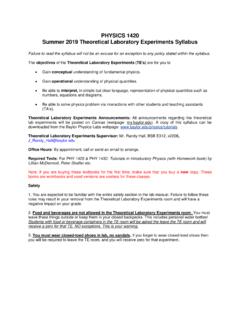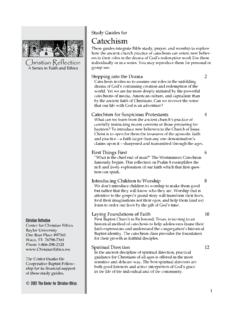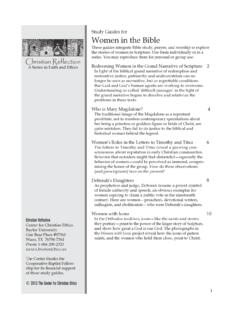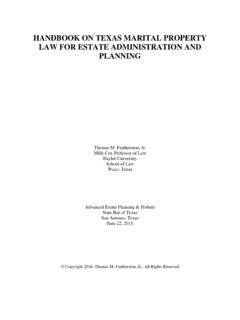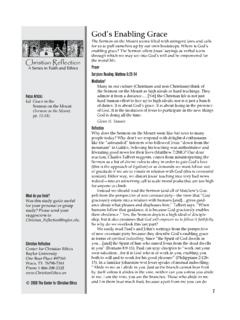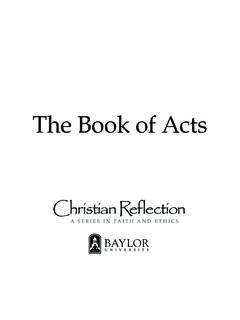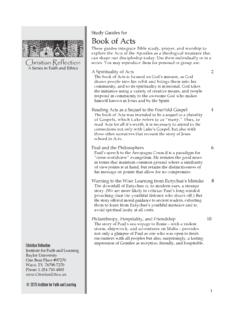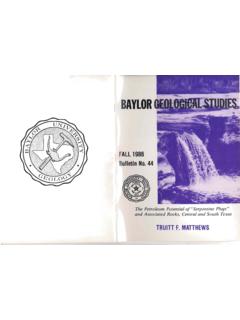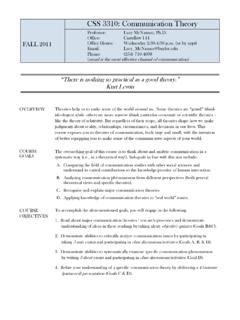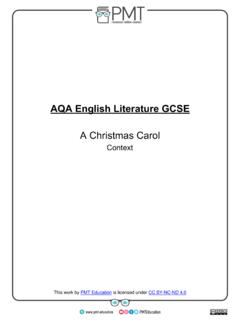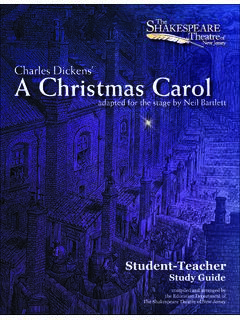Transcription of The History of Christmas - Baylor
1 84 Copyright 2011 Center for Christian Ethics at Baylor UniversityThe History of ChristmasBy G. Sujin PakEver wonder how December 25th became the date to cel-ebrate Christmas , or the History behind Santa Claus? Did you know that Christians in the first three centuries of the Church did not celebrate Christmas ? These questions and many more are answered in the four books reviewed you ever wondered how December 25th became the date to celebrate Christmas ? Did you know that Christians in the first three centuries of the Church did not celebrate Christmas ? What is the History behind Santa Claus? How has the observance of Christmas changed or developed over time? These questions and many more are answered in the four books reviewed here. Despite some repetition among them concern-ing the History , theology, and practices of Christmas , each volume makes a distinctive contribution to the conversation.
2 They awaken us to how sensi-tive this topic can be, for Christmas is close to the hearts of many people whether they are observant Christians or secular of the books The Origins of Christmas and The Feast of Christmas by Joseph F. Kelly, and Christmas : Festival of Incarnation by Donald Heinz highlight the religious History and practices of Christmas . The purpose of Bruce Forbes s pithy tome Christmas : A Candid History is quite different: it seeks to portray a concise candid History of how Christmas developed in both its secular and religious elements (x-xi). Yet, all four books express several important themes: they underscore that Christmas has had secular features from its origins (Kelly, Origins, 60-68, 129; Heinz, 106-107; Forbes, 141-142), and encourage readers to appreciate both the religious and secular facets of Christmas and not to assume an inherent conflict between them (Kelly, The Feast, ix; Heinz, xii, 221; Forbes, 153).
3 The real enemy of Christ-mas, they argue, is not its secular accoutrements, but consumerism (Kelly, The Feast, 101-102; Heinz, 222-229; Forbes, 112-118). The History of Christmas 85 YThe Origins of Christmas (Collegeville, MN: Liturgical Press, 2004, 151 pp., $ ) is the stronger of the two authored by Joseph Kelly. He begins with an insightful survey of the Nativity narratives in Matthew and Luke that highlights the distinctive theological themes of each one. Noting that there are questions about the historicity of the accounts, he recognizes that the gospel writers are concerned to present not History per se, but a rich and informed theology (13). The best contribution of this book, especially for Protestant readers, is Kelly s tracing how certain Old Testament passages, early Christian apocry-phal books, and teachings of the church fathers augment the Christmas story.
4 For instance, the Gospels do not mention there being any ox or donkey at the manger scene or camels with the Magi; they do not mention the number of Magi and do not describe them as kings. Our common assumptions about these matters stem from the use of Old Testament passages (Isaiah 1:2-3; 60:3, 6, 10-11; and Psalm 72:10) and early Christian apocryphal texts to inform the Christmas story. Kelly demonstrates how these sources added significantly to visual depictions of the Nativity. For example, a popular medieval document, the Gospel of Pseudo-Matthew, places an ox and a don-key at the manger scene (based on its use of an erroneous translation of Habakkuk 3:2) and serves as the source for the Cherry Tree Carol, in which the infant Christ orders a fruit tree to bend to feed a wearied Mary. Furthermore, several distinctively Catholic beliefs surrounding the Nativity have these apocryphal narratives as a main source.
5 For instance, the Proto-evangelium of James depicts Joseph as an old widower with two sons from a prior marriage and names Anne as Mary s mother. This text also speaks of both a virginal conception and a virginal birth, in which Mary s virginity remains intact even after giving contributions of the church fathers to the development of Christmas appear most clearly in the dating of Christmas and expansion of its liturgical season. Among these four books, Kelly offers the best account of this History . He shows how the Christological debates in the early church influenced the formation of Christmas , and how writings of the church fathers added other aspects to the Christmas story, especially concerning the Magi. For example, by paralleling the story of the Magi with Genesis 22, Origen set forth the tra-dition of three Magi. Yet, Kelly s book concludes rather rapidly and sketchily with very brief accounts of St.
6 Nicholas and the roles of Christmas art and music. Here the book would have been better served by remaining true to its strength of giving an account of the texts that inform the origins of Christmas and leaving these latter subjects for a future s second book on Christmas , The Feast of Christmas (Collegeville, MN: Liturgical Press, 2010, 121 pp., $ ), repeats in succinct form the contents of the prior book, but with less eloquence and helpful detail. New material finally appears in chapter four with a depiction of the role of feast 86 Christmas and Epiphany days in the expansion of the Christmas season. Yet this description is based upon a singular account, The Golden Legend of Jacob of Voragine, which the author uses to exhibit how the myths and legends surrounding Christmas had grown and reached acceptance by a wide audience (50-51). This is sup-plemented by an account of the Corpus Christi plays as a further illustration of how legends deeply informed the narration of Christmas .
7 Ultimately, this chapter lacks persuasive-ness for three reasons. First, its claims are based on a small amount of evidence. Secondly, it does not make clear the significance and role of feast days and feast-ing for the Christmas cele-bration. Finally, the points so helpful in his former book about supplemental features to Christmas that come from the church fathers and Christian apocryphal books are called legends in this most significant contribution of The Feast of Christmas is tracing the growth of the secular Christmas from the sixteenth century forward in Eng-land and the United States through the influence of key figures like Wash-ington Irving, Clement Clarke Moore, and charles dickens , and the Puritan rejection of Christmas . Here, as in his first book, the detail and clarity of his historical account shine. Yet, the stated focus on the feast of Christmas ultimately remains unclear throughout the book.
8 In the end, Kelly s contri-bution to the larger conversation is that he is the better historian in this group of authors, and his first book is the better read. YDonald Heinz s Christmas : Festival of Incarnation (Minneapolis, MN: For-tress Press, 2010, 274 pp., $ ) is a welcome partner to this conversation. At its most eloquent and profound moments, this book offers a theological reflection of Christmas as a celebration of the Incarnation. Heinz endeavors to portray the ways in which Christmas inaugurates and plays out the risks and realizations of Incarnation (xii). Hence, the author encourages Chris-tians to perceive in the material culture of Christmas in both its religious and secular forms the possibility that God could be at work here in autho-rizing ever widening vernaculars (222, 88-89). Heinz aims to broaden our imaginations of the possibilities of Incarnation, especially pertaining to Heinz broadens our view of the possibilities of incarnation.
9 Or, perhaps to state it in the vernacular: God gets carried away at Christmas . in this festival, incarnation spills out of its religious vessel to saturate secular material culture. The History of Christmas 87 Christmas , so that we might better recognize how wide the space is for Divine Presence through an expansive affirmation of material culture. Or, perhaps to state it in the vernacular: God gets carried away at Christmas (129). In this festival, Incarnation spills out of its religious vessel to saturate secular material culture. The body of the book is a depiction of various material forms of Christ-mas as forms of Incarnation. Heinz employs the concept of Christian worship as theater to discuss the historical and theological uses of Christmas plays and manger scenes, and to emphasize the centrality of liturgy and sacra-ments to Christian worship more generally and the celebration of Christmas in particular.
10 He seeks to remind Protestants that material culture images, ornamentation, theater, and music has provided rich resources of envi-sioning, experiencing, and hearing Incarnation in the History of the Church. The book concludes by interpreting the secular accoutrements of Christmas as ornamenting the Incarnation with further visual and musical incarna-tions through the varieties of feasting, wrappings, lights, trees, and music of Christmas . To take one single example, St. Nicholas can serve as an invi-tation to a return to wonder and enchantment (168), that we might see the possibility of miracles once Heinz depicts the ways in which Incarnation spills out beyond its religious vessel at Christmas , he warns that the reverse can and does happen too: secular culture can start to saturate Christian Christmas practices. This is most evident in the influences of consumer capitalism.
